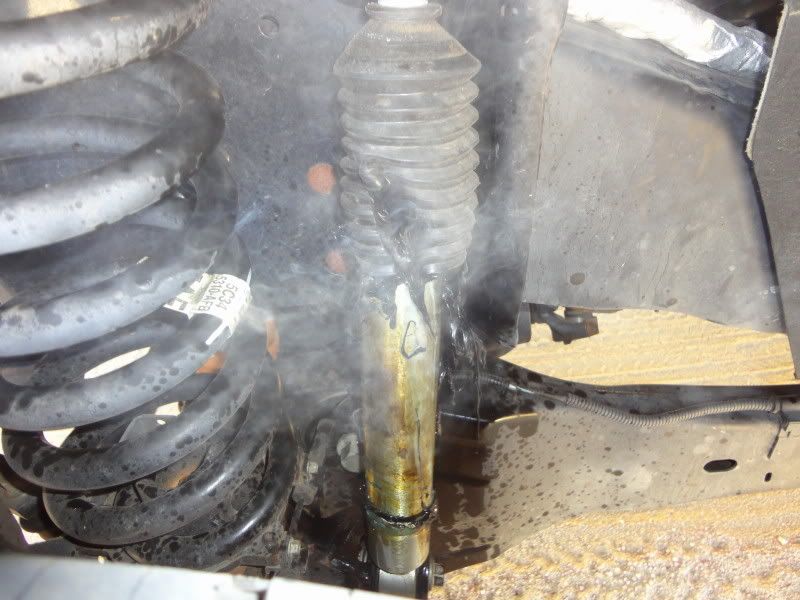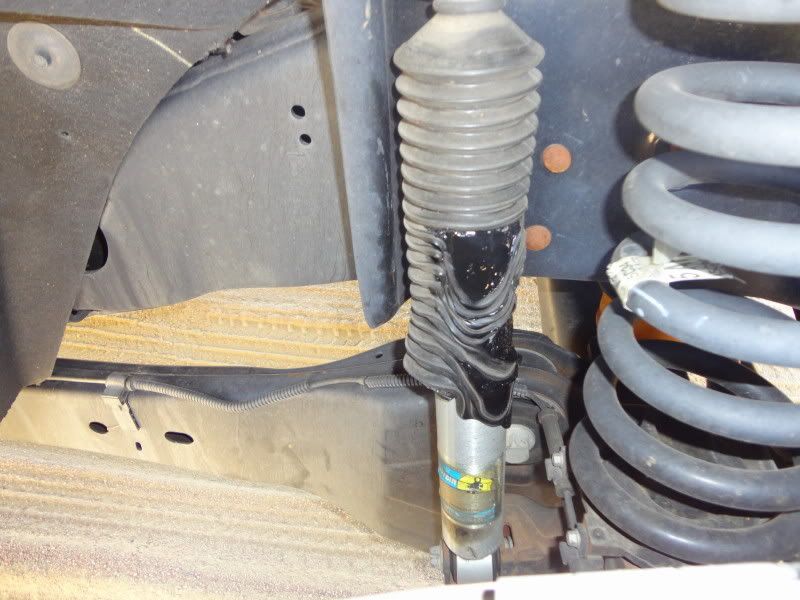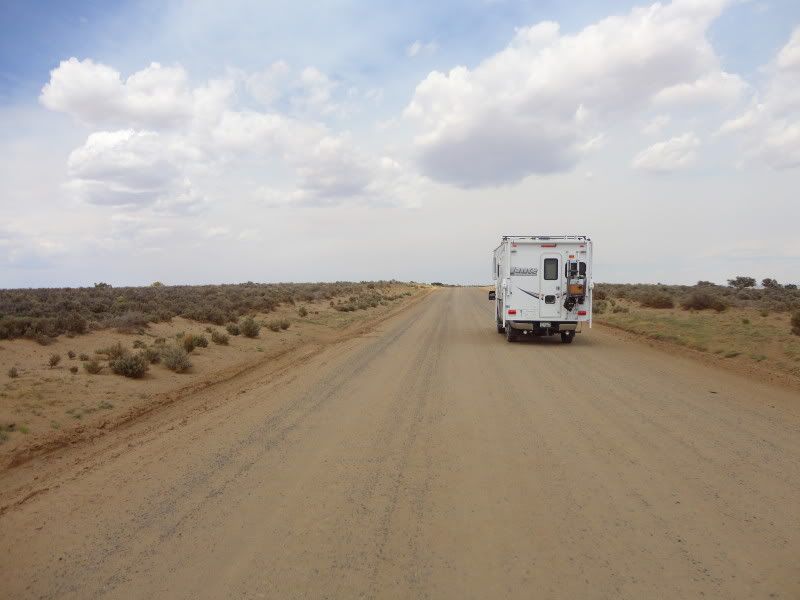Forum Discussion
- RZAR66ExplorerWell I decided to go with the Rancho 9000xl's and installed them a couple of days ago. I swear the Ranchos were twice as big as the Bilstiens in diameter, if that means anything. I always thought the adjustment knob thingy was a gimmick but I can actually feel a difference between adjustments. I have been using different settings each time I go to work so I can compare settings on the same road everyday. Turned the dial to 1 on all four today and the truck felt really soft and slightly bouncy. Yesterday at 9 and it felt real firm and solid. Next test will be with the 3200 lb. Lance camper riding piggy back.
- nycsteveExplorer
RZAR66 wrote:
nycsteve wrote:
Again,get some Ranchos.
LOL I hear ya nycsteve. I think I remember you having the same truck as mine and a Lance camper. How much improvement have you noticed with the Rancho 9000s?
Im very happy with the Ranchos. They hold up to beach driving well. The effect on the rigs handling is noticable and positive. The other big bang for the buck was the addition of Supersprings Sway Stopper. Simple and very effective at controling side to side sway.
I havnt needed to call Rancho on thier lifetime warrenty but I hope Im treated better than Bilstien does if I do. I did hear from others on this forum that Rancho stood by thier warranty ,but keep the reciept.
As for the adjusting with the Ranhos, I leave it on max with or without the TC.Its a truck ,I wont try to turn it into a car ride. - DWeikertExplorer II
skipro3 wrote:
Your suspension doesn't just 'fall' by gravity though...
It's pushed by the stored energy of the compressed spring. Ever see how much energy a spring that's been compressed a few inches by a ton when it's released. Moves pretty fast!!
By your description, the tire is airborne and SLAMS into the next washboard bump; a very harsh ride indeed!!!
I race off road motorcycles and have spent a lot of time with suspension in washboard conditions. I can tune a shock so the bike rider isn't even aware that he's traveling over anything more uneven than asphalt paving while the washboard is up to 10" deep. (13" of suspension travel in the shock.) Smooth as silk. Even more; there's not only compression and rebound on damping, there's high speed and low speed damping. Wash board is low speed; where the ground transitions fairly smoothly in rolling ground. High speed damping is with an abrupt edge. Like maybe hitting a curb head-on at speed.
Then there is damping for the various area of the shock's piston stroke; initial / mid and end of the stroke. This allows a shock to have stiffer damping as the shock piston is moved through it's stroke.
Shock engineering is quite a science.
I see your point and agree, to a point. It's a balancing act. Those shocks you tuned to ride comfortably on a 10" deep washboard would probably give a terrible ride on a 3" washboard with a different spacing. I still believe my explanation of the tire basically flying between bumps is why speed smooths out the washboard. The trick is finding the right speed for the particular washboard. - Ski_Pro_3Explorer
You're not taking into consideration that gravity is only 32 ft/sec^2. It takes time for a tire to fall from the peak of the ridge to the valley, especially if the wheel has a little upward momentum left over from going up the ridge. If the tire reaches the next ridge before it can fall all the way into the valley, it smooths out the washboard.
Your suspension doesn't just 'fall' by gravity though...
It's pushed by the stored energy of the compressed spring. Ever see how much energy a spring that's been compressed a few inches by a ton when it's released. Moves pretty fast!!
By your description, the tire is airborne and SLAMS into the next washboard bump; a very harsh ride indeed!!!
I race off road motorcycles and have spent a lot of time with suspension in washboard conditions. I can tune a shock so the bike rider isn't even aware that he's traveling over anything more uneven than asphalt paving while the washboard is up to 10" deep. (13" of suspension travel in the shock.) Smooth as silk. Even more; there's not only compression and rebound on damping, there's high speed and low speed damping. Wash board is low speed; where the ground transitions fairly smoothly in rolling ground. High speed damping is with an abrupt edge. Like maybe hitting a curb head-on at speed.
Then there is damping for the various area of the shock's piston stroke; initial / mid and end of the stroke. This allows a shock to have stiffer damping as the shock piston is moved through it's stroke.
Shock engineering is quite a science. - RZAR66Explorer
nycsteve wrote:
Again,get some Ranchos.
LOL I hear ya nycsteve. I think I remember you having the same truck as mine and a Lance camper. How much improvement have you noticed with the Rancho 9000s? - RZAR66Explorer
nycsteve wrote:
Again,get some Ranchos.
LOL I hear ya nycsteve. I think I remember you having the same truck as mine and a Lance camper. How much improvement have you noticed with the Rancho 9000s? - DWeikertExplorer II
skipro3 wrote:
Hodag1 wrote:
On washboard roads the tire travels on the ridges of the ruts as speed increases therefore decreasing shock travel and heat. This is according to the engineering rep for Fox shocks at the overland expo
If your shock isn't allowing the tire to keep in full contact with the road at speed, then it's not doing it's job properly. As a reminder, shock DAMPEN the oscillation of the suspension moving up and down. The springs allow for travel in the suspension. If the suspension is not moving up and down at speed due to the shock's inability to dampen AND travel the same length as the spring needs to travel in order to keep the tire in contact with the ground, then the shock is way too 'stiff' or slow in it's rebound valving, and could be way too soft on it's compression valving. (If the shock even has metering that has independent compression and rebound damping.)
You're not taking into consideration that gravity is only 32 ft/sec^2. It takes time for a tire to fall from the peak of the ridge to the valley, especially if the wheel has a little upward momentum left over from going up the ridge. If the tire reaches the next ridge before it can fall all the way into the valley, it smooths out the washboard. - nycsteveExplorerAgain,get some Ranchos.
- Ski_Pro_3Explorer
Hodag1 wrote:
On washboard roads the tire travels on the ridges of the ruts as speed increases therefore decreasing shock travel and heat. This is according to the engineering rep for Fox shocks at the overland expo
If your shock isn't allowing the tire to keep in full contact with the road at speed, then it's not doing it's job properly. As a reminder, shock DAMPEN the oscillation of the suspension moving up and down. The springs allow for travel in the suspension. If the suspension is not moving up and down at speed due to the shock's inability to dampen AND travel the same length as the spring needs to travel in order to keep the tire in contact with the ground, then the shock is way too 'stiff' or slow in it's rebound valving, and could be way too soft on it's compression valving. (If the shock even has metering that has independent compression and rebound damping.) - DWeikertExplorer II
RZAR66 wrote:
...they don't make a shock for how I use my truck (carrying a TC offroad)...
So now a gravel road is "offroad"?
About Travel Trailer Group
44,030 PostsLatest Activity: Feb 06, 2025


